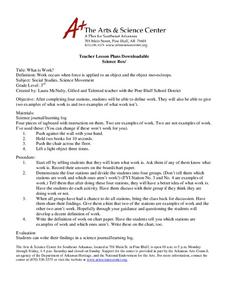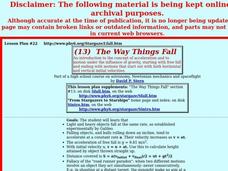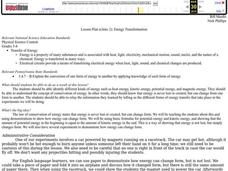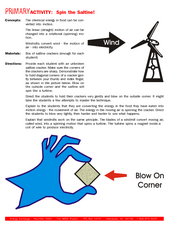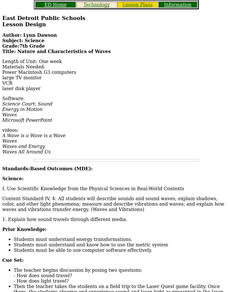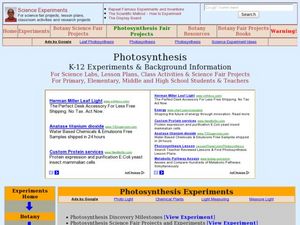Curated OER
The Seasons of Thanks
First graders explain the Native American cyclical concept of time
Curated OER
Units and Measurement
Students discuss the word weight, how much they weigh and the conccept of heavy and light. They hear the story of measurement and the metric system. They work in groups and measure and record items found in the classroom and use a...
Curated OER
Energy Conversion in Electricity – Resistors and Circuits
Students explore electrical energy. In this electricity lesson plan, students design and build a large circuit in order to determine whether circuit size correlates with the light of a bulb.
Curated OER
What is Work?
Third graders investigate the concept of force and work. In this physics lesson, 3rd graders visit four stations which include pushing the wall with your hand, holding books for ten seconds, pushing a chair, and lifting a light object....
Curated OER
Air: Demonstrating Its Presence and Effects
Young scholars explore the concept of air. In this gravity lesson, students perform various experiments that deal with gravity, air resistance, and air pressure.
Curated OER
Weather
Students participate in a variety of mini-lessons including experiments, literature readings, physical education components, music, data gathering and recording and more to expose them to several themes of weather; i.e. water cycle,...
Curated OER
The Way Things Fall
Students explore concept of acceleration and motion under the influence of gravity, starting with free fall and ending with motions that start out with both horizontal and vertical initial velocities.
Curated OER
Riding the Gravity Wave
Students write a sketch of an artist or athlete that has pushed the limits on gravity. They explore concepts of rhythm, balance and friction. They examine how engineers design sports equipment.
Curated OER
Introduction to AP Chemistry
Students are introduced to concepts in an AP Chemistry class. They work together to complete experiments on different materials. They discuss the results of the experiments.
Curated OER
Solstice And Equiniox Curriculum
Students engage in a lesson that investigates finding the dates of the solstices and equinoxes. They define the terms related to the concept and conduct research in order to explain the physical occurrences. They also relate to how the...
Curated OER
Energy Transformation
Students identify different kinds of energy such as heat energy, kinetic energy, potential energy, and magnetic energy. They investigate the concept of conservation of energy.
Curated OER
Spin the Saltine!
Students investigate chemical energy. In this physical science lesson, students blow on saltine crackers to demonstrate how chemical energy in food can be converted to motion. Students compare the saltine cracker experiment to how...
Mr. E. Science
The Periodic Table
This science presentation focuses on the elements in the periodic table. It begins with the parts of an atom, explaining atomic mass and atomic number, valence electrons, and isotopes. Then it moves on to discuss various ways of...
Curated OER
Nature and Characteristics of Waves
Seventh graders research different types of waves, identify the parts of a wave and create a Power Point presentation demonstrating what they have learned.
Curated OER
Probes, Exploration and Application
Students examine the benefits of the space program to our life on earth. In this space exploration lesson students participate in a lab, answer questions and study radar mapping.
Curated OER
Keep It Hot
Students design and conduct an experiment to explore the insulating abilities of different materials for keeping a liquid in a paper cup warm. A small group of lab partners test four different materials: black paper, white paper,...
Curated OER
Photosynthesis
Young scholars explore the concept of photosynthesis. They describe the light and light independent reactions of photosynthesis. Students relate physical plant characteristics to their functions. They distinguish between C3, C4, and CAM...
Curated OER
Thinking About Newton's 1st Law
Pupils discuss the lives of both Aristotle and Newton in order to bring important differences between the two to the forefront. They evaluate two statements about motion and use the ideas from the discussion to determine which statement...
Curated OER
The Farther Away You Are, The Faster Away You Move
Pupils explore linear relationships. The instructional activity uses science to develop an understanding of the expanding Universe. There are 3 Labs, only 2 of which are required. Lab C is an enrichment for higher level classes.
Curated OER
Sizing Up Sound
Sixth graders are introduced to the concepts of sound waves and frequency. As a class, they listen to the differences between different types of instruments. To end the lesson, they practice identifying low and high pitches and playing...
Curated OER
Microscopes and Crystals
Students observe crystals under the microscope. In this science lesson, students compare how the crystal look like using their eyes, hand lens and microscope. They identify the type of crystal based on the amount of light they allow to...
Curated OER
Motion Through the Ages
Eighth graders conduct internet research to produce a timeline of man's growth in understanding of concepts of motion and planetary motion through history.
Curated OER
How Do You Get To Korea?
Students examine the differences between Korea and the United States. In groups, they identify the physical and political characteristics of Asia and discuss how the geographic features in Korea affect the activities performed there. ...
Curated OER
Peak Flow Meter Exercise
Students investigate the concept of lung capacity. They use flow meters to measure the maximum capacity of themselves and others. The data is collected in order to make some conclusions concerning the mean of individual lung capacity....





